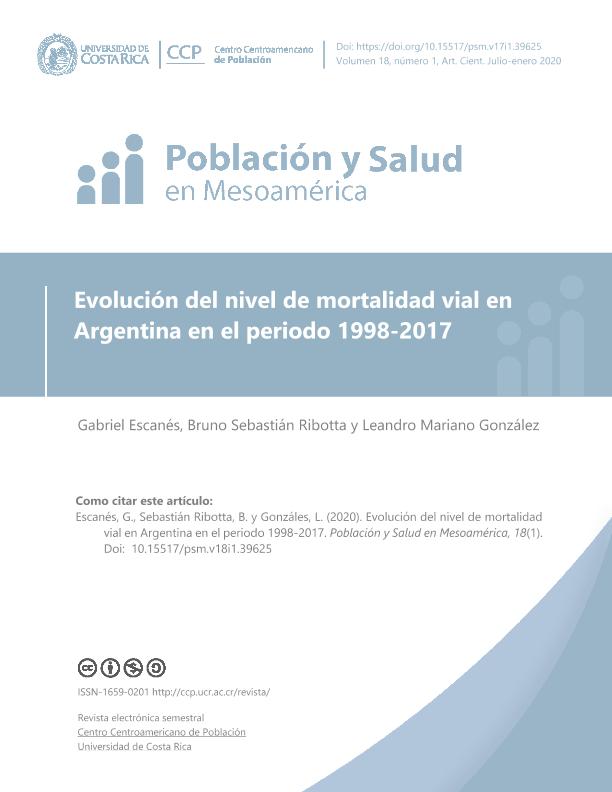Artículo
Determinar el impacto que tuvieron las muertes por atropellos de peatones y colisiones entre vehículos sobre la esperanza de vida en Argentina durante el periodo 1998-2017. Material y métodos: Se obtuvieron las bases de datos sobre las causas de muerte, sexo, edad y jurisdicción de residencia de los fallecidos de la Dirección de Estadísticas e Investigación en Salud de Argentina. Se calcularon las tasas de mortalidad y el indicador de los años de esperanza de vida perdidos (AEVP) para determinar el impacto de la mortalidad vial. Resultados: Argentina redujo en un 13% los fallecimientos por atropellos de peatones y choques entre vehículos durante los últimos 20 años. La tasa de mortalidad vial pasó de 12,0 a 10,6 defunciones cada 100.000 habitantes entre los trienios 1998-2000 y 2015-2017 respectivamente. Los decesos en el tránsito tuvieron mayor impacto entre los hombres de edades de 15 a 49 años. Al mismo tiempo, hubo un fuerte contraste del nivel de mortalidad vial registrado en cada una de las jurisdicciones del interior del país, donde las tasas de mortalidad oscilaron entre 1,2 y 24,1 decesos cada 100.000 habitantes. Conclusiones: Si bien hubo una disminución del nivel de mortalidad vial, las políticas públicas implementadas en Argentina no han logrado el objetivo de reducir a la mitad la cantidad de defunciones. Este flagelo sigue generando la destrucción y desarticulación de las familias residentes en el país. Es necesario la implementación de nuevos programas que apunten a reducir las conductas violatorias de las normas de tránsito. To determine the impact that the deaths caused by pedestrian abuses and vehicle collisions had on life expectancy in Argentina during the period 1998-2017. Material and methods: The databases on the causes of death, sex, age and jurisdiction of residence of the deceased of the Directorate of Health Statistics and Research of Argentina were obtained. Mortality rates and the indicator of years of life expectancy lost (YLEL) were calculated to determine the impact of road mortality. Results: Argentina reduced by 13% the number of deaths due to pedestrian accidents and collisions between vehicles during the last 20 years. The road mortality rate went from 12.0 to 10.6 deaths per 100.000 inhabitants between the triennia 1998-2000 and 2015-2017, respectively. Deaths in transit had a greater impact among men aged 15 to 49 years. At the same time, there was a strong contrast in the level of road mortality recorded in each of the jurisdictions in the interior of the country, where mortality rates ranged from 1.2 to 24.1 deaths per 100,000 inhabitants. Conclusions: Although there was a decrease in the level of road mortality, public policies implemented in Argentina have not achieved the objective of halving the number of deaths. This scourge continues to cause destruction and disarticulation of families residing in the country. It is necessary to implement new programs that aim to reduce the behaviors that violate traffic regulations.
Evolución del nivel de mortalidad vial en Argentina en el periodo 1998-2017
Título:
Evolution of the level of road mortality in Argentina in the period 1998-2017
Fecha de publicación:
06/2020
Editorial:
Universidad de Costa Rica. Centro Centroamericano de Población
Revista:
Población y Salud en Mesoamérica
ISSN:
1659-0201
e-ISSN:
1659-0201
Idioma:
Español
Tipo de recurso:
Artículo publicado
Clasificación temática:
Resumen
Archivos asociados
Licencia
Identificadores
Colecciones
Articulos(CIECS)
Articulos de CENTRO DE INVESTIGACIONES Y ESTUDIO SOBRE CULTURA Y SOCIEDAD
Articulos de CENTRO DE INVESTIGACIONES Y ESTUDIO SOBRE CULTURA Y SOCIEDAD
Citación
Escanés, Gabriel Adrián; Ribotta, Bruno Sebastián; Gonzalez, Leandro Mariano; Evolución del nivel de mortalidad vial en Argentina en el periodo 1998-2017; Universidad de Costa Rica. Centro Centroamericano de Población; Población y Salud en Mesoamérica; 18; 1; 6-2020
Compartir
Altmétricas




